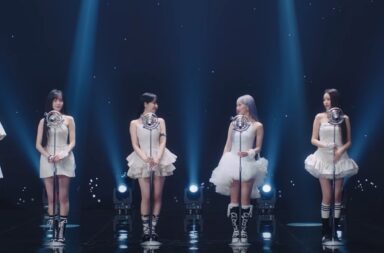 Earlier this week, Sistar dropped “One More Day”, a collaboration with Italian producer and EDM pioneer Giorgio Moroder that was announced back in September as part of MU:CON 2016 in Seoul. As if the existence of this collaboration isn’t mind-blowing enough, the MV makes jaws drop with a carefully, powerfully crafted thriller romance that breaks away from heteronormativity by portraying a lesbian couple.
Earlier this week, Sistar dropped “One More Day”, a collaboration with Italian producer and EDM pioneer Giorgio Moroder that was announced back in September as part of MU:CON 2016 in Seoul. As if the existence of this collaboration isn’t mind-blowing enough, the MV makes jaws drop with a carefully, powerfully crafted thriller romance that breaks away from heteronormativity by portraying a lesbian couple.
Note: This MV and review contains references that relate to and may conjure images of domestic abuse.
The electronic pop dance number opens with organ-like synths that introduce a sense of gravitas sustained throughout the song. It bubbles and pulses with a restrained but palpable emotional intensity. This suits the tone of the lyrics, which express the persona’s weary yet conflicting feelings towards the end of her relationship, a soliloquy of sorts that culminates in her decision to let go.
The MV adapts the lyrics into a back story for model Song Hae-na‘s character. For ease of reference, I will be referring to Hae-na’s character as Hae-na, and Hong Soo-hyun‘s character as Soo-hyun, since both characters are unnamed. The MV opens with an unfocused long shot; in the background are the silhouettes of the two main characters dragging a suitcase. The blue lighting and blurry visuals create an air of mystery that is reinforced by close-ups on each woman looking troubled and paranoid, and a close-up on the suitcase.

Through an anachronistic narrative, the viewers discover that the two women are friends-turned-lovers. After one of their nights out partying, Hae-na’s abusive ex-boyfriend shows up and starts beating her up. In a moment of desperation and hatred, both women hit him on the head with a brick and two liquor bottles, committing manslaughter. Realising there’s no way back, they hide the corpse in a huge suitcase, and set it — and a perfectly functional BMW I wouldn’t mind having — aflame to destroy evidence of the crime.
The thriller narrative definitely grabs more attention on the first watch, but what is truly exceptional about the MV is the portrayal of the main characters’ relationship. Plot-wise, some viewers have noted points of similarity between this MV and t.A.T.u.‘s “All About Us”, as well as a more recent release, Hayley Kiyoko‘s “Girls Like Girls”. But “One More Day” differs in tone and production quality, making more concerted use of cinematography and editing to draw out a beautiful yet nightmarish atmosphere, and to draw the viewer into the romance.
 Lighting in particular is employed throughout to reflect the changing emotional states of the characters, the subtle variation in mood, and to demarcate time. Following the enigmatic opening scene, a pull-back shot brings the viewer into a bedroom where Hae-na rests on Soo-hyun’s lap. The lighting scheme is still predominantly blue and purple, but the pink tones bring out a sense of intimacy confirmed by the women’s gestures of affection towards each other — Soo-hyun strokes Hae-na’s hair slowly, while Hae-na absently caresses Soo-hyun’s thigh.
Lighting in particular is employed throughout to reflect the changing emotional states of the characters, the subtle variation in mood, and to demarcate time. Following the enigmatic opening scene, a pull-back shot brings the viewer into a bedroom where Hae-na rests on Soo-hyun’s lap. The lighting scheme is still predominantly blue and purple, but the pink tones bring out a sense of intimacy confirmed by the women’s gestures of affection towards each other — Soo-hyun strokes Hae-na’s hair slowly, while Hae-na absently caresses Soo-hyun’s thigh.
A Dutch tilt throws the scene off-balance, and the screen image fragments in sync with a warp in the synths of the song leading up to the next verse, ghosting as though on a faulty TV. The greenish-yellow lighting, paired with the characters’ behaviour, informs the viewer that this is a scene from the past. As the two sit side-by-side sharing music, Hae-na glances at Soo-hyun’s profile; a close-up brings us into Hae-na’s point of view. Sensing her gaze, Soo-hyun turns, and Hae-na looks away quickly. But Soo-hyun has caught on and she smiles, which makes Hae-na smile shyly as well.
 Here, the soft lighting and subtle red tones hint at the attraction the pair share, reinforced by the non-diegetic insert of a match being struck. The same lighting scheme is used in the scene where the women apply lip gloss for each other, but the red tones are more obvious. This cues the viewer into the heightened intensity of their feelings which leads up to the kiss that likely marks the start of their relationship. The choice of imagery in the following shot is also interesting: white paint swirls onto red roses, inverting the usual progression from white (as innocence) to red (as romance and passion).
Here, the soft lighting and subtle red tones hint at the attraction the pair share, reinforced by the non-diegetic insert of a match being struck. The same lighting scheme is used in the scene where the women apply lip gloss for each other, but the red tones are more obvious. This cues the viewer into the heightened intensity of their feelings which leads up to the kiss that likely marks the start of their relationship. The choice of imagery in the following shot is also interesting: white paint swirls onto red roses, inverting the usual progression from white (as innocence) to red (as romance and passion).
Lighting is further manipulated in later scenes. Strong blue lighting drives home Hae-na’s sorrow and suffering after her ex-boyfriend beats her up during Soo-hyun’s absence one day. In the post-party scene, when Hae-na and Soo-hyun stumble home, all tipsy and giggly, the greyish-blue, ordinary-looking background is contrasted with red lighting cast on their faces that foreshadows the approaching danger. As Soo-hyun helplessly watches the ex going after Hae-na, the entire shot is awash with red lighting, conveying her sense of crisis.
 What makes the narrative compelling is also the way viewers are brought into the intimate physical and emotional spaces of the characters. There is no dialogue; the images are not narrated to be processed rationally, but instead are constructed to be felt.
What makes the narrative compelling is also the way viewers are brought into the intimate physical and emotional spaces of the characters. There is no dialogue; the images are not narrated to be processed rationally, but instead are constructed to be felt.
The couple is almost always portrayed in isolation. In addition, the frequent use of close-up framing captures the stellar acting that conveys depth of feeling through small gestures, expressions, and silent exchanges of gazes. Together, these allow the viewer to feel strongly the rawness of emotions the girls feel: pure joy, or peacefulness and safety when they are together, and Hae-na’s anguish and Soo-hyun’s silent fury when the abusive ex makes his return.

While the Korean entertainment scene still lacks overt, empathetic portrayals of LGBTQ characters, there have been traces of growing awareness of such issues and communities in recent years. Recent examples featuring gay characters are Reply 1997 and the MV for K.Will’s “Please Don’t”, as well as Hogu’s Love which portrays a main character’s confusion over his sexuality in a comic manner, but beneath the hijinks, compellingly probes the prejudice that gay men face.
There have been comparatively more works focusing on lesbian experiences, such as the MV for “She is a Flirt” with pre-debut Lovelyz member Baby Soul (albeit a very subtle representation), the web series Lily Fever, Seonam Girls High School Investigators (the first K-drama to feature a lesbian kiss), and most recently, the film The Handmaiden. Unlike the above-mentioned portrayals of gay characters, which tend to frame the characters’ romantic experiences as unrequited love, these works present characters in lesbian relationships, an interesting difference that could perhaps be explored in another discussion.
 “One More Day” takes on a lesbian relationship in its own way, featuring not just a bisexual character in Hae-na, but one who breaks away from an abusive heterosexual relationship. This is, I believe, not merely a decision to heighten the drama of the plot, but one that may rest on the intersectionality of a lesbian woman’s experience in Korea. This is not to suggest that there isn’t a possibility of a gay man facing violence as a result of his sexuality, but that sexuality, when combined with the gender of an individual, is implicated in a different social dynamic.
“One More Day” takes on a lesbian relationship in its own way, featuring not just a bisexual character in Hae-na, but one who breaks away from an abusive heterosexual relationship. This is, I believe, not merely a decision to heighten the drama of the plot, but one that may rest on the intersectionality of a lesbian woman’s experience in Korea. This is not to suggest that there isn’t a possibility of a gay man facing violence as a result of his sexuality, but that sexuality, when combined with the gender of an individual, is implicated in a different social dynamic.
Within the K-pop world, domestic violence has been brought to the fore in MVs like Purfles‘ “A Bad Thing” and Ga-in’s “Fxxk U”, as well as the Kim Hyun-joong saga among other instances. Aside from the complexity of the cycle of abuse, what surfaces from these cases, anecdotes, polls, and studies beyond K-pop, is that the proportion of victims are overwhelming female, and the perpetrators are overwhelmingly male.
Through the plot, “One More Day” sends across a powerful call to resist abusive relationships and seek healthy, mutually supportive ones. Transgressive as the act of manslaughter is, it is hard to deny that the moment the glass bottle shattered on contact with the ex’s head is subversively satisfying, because it is an act of standing up against one’s oppressor after suffering repeatedly under his abuse.
 It is important to note that the MV is not encouraging victims of domestic violence to retaliate against their abusers by murdering them: it is evident from the women’s response and facial expressions that they know they’ve done something unacceptable, even if their actions were motivated by self-defence and an understandable impulse for revenge. But there are two important underlying messages: no one should suffer such abuse in silence, or have to face it alone—a large part of why victims find it difficult to act on their abuse is that relationships are viewed as a private, individual issue.
It is important to note that the MV is not encouraging victims of domestic violence to retaliate against their abusers by murdering them: it is evident from the women’s response and facial expressions that they know they’ve done something unacceptable, even if their actions were motivated by self-defence and an understandable impulse for revenge. But there are two important underlying messages: no one should suffer such abuse in silence, or have to face it alone—a large part of why victims find it difficult to act on their abuse is that relationships are viewed as a private, individual issue.
Further, reflecting on the manslaughter from a distanced, rational perspective marks it as morally problematic, but the MV is precisely resisting such a perspective. Like how it brings the viewer into the romance, here it co-opts the viewer into the psychological and emotional perspective of the characters to experience this moment, driven by a mix of alcohol, adrenaline, and above all, pent-up hatred from a history of being abused (Hae-na) and of helplessly watching a loved one being abused (Soo-hyun).
 The most striking moment in the sequence was not the one in which Hae-na smashes the bottle on her ex’s head, but the shot of her face twisted in anguish and hatred just before she strikes. This choice shot crystallises all her past traumas and the deep psychological and emotional damage inflicted on her. It is infinitely more powerful than showing the actual scenes of abuse through flashbacks.
The most striking moment in the sequence was not the one in which Hae-na smashes the bottle on her ex’s head, but the shot of her face twisted in anguish and hatred just before she strikes. This choice shot crystallises all her past traumas and the deep psychological and emotional damage inflicted on her. It is infinitely more powerful than showing the actual scenes of abuse through flashbacks.
A final layer of meaning I would like to explore is that of the domestic abuse plot being a covert allegory for the struggles that the queer community experiences because of societal norms and pressures. As this reading is not as well-supported by examples from the MV, I encourage it to be taken with a few pinches of salt, but it’s still a possibility that I want to keep open for consideration.
There is a narrative gap between Hae-na’s break-up and the beginning of her relationship with Soo-hyun, so the viewer doesn’t know when and why Hae-na’s boyfriend started abusing her. The only thing that’s clear is that Hae-na realises something unusual about Soo-hyun’s feelings about her and her then-boyfriend.

The break-up could have stemmed from her awareness of her growing attraction for Soo-hyun, which then angered her ex into violence; or from her desire to break away from the abusive relationship, if the abuse had already begun before the break-up. Either way, there is a likelihood that Hae-na is being persecuted for being in a lesbian relationship. Read this way, her ex’s abuse can take on an added meaning, symbolic of the emotional and physical violence that society and its members inflicts on homosexual individuals.
In this light, “One More Day” functions on multiple intertwined levels: as a call to fight against domestic abuse, and as a covert protest against the oppression of the queer community. But the MV is not primarily dialectical. Above all, it pushes against homophobic prejudice by bringing viewers into the perspective of its characters, in hopes that they will see and feel how love is love, even if the people in love differ from the gender and sexual norm.
As several YouTube users have noted, the MVs of artists under Starship Entertainment have been displaying a steady pattern of queer representation. This exists on a spectrum, from hints of homoeroticism in Monsta X‘s “All In” and Sistar’s “I Like That”, to more clearly homosexual characters in “Please Don’t” and now in “One More Day” (which is produced by Fluxus Music under Loen Entertainment, of which Starship is a subsidiary).

At this point, it’s not entirely accurate to claim that Starship supports LGBTQ rights, since it is unclear whether the impulse to engage with these issues stems from the company or the creative professionals they work with. At the very least, though, they appear to be granting the producers creative license to broaden the types of relationships and experiences portrayed in their artists’ MVs. Regardless of whose decision it is, this kind of inclusiveness of representation is something I hope we see more of.
MV Rating: 4.75/5
(YouTube, Images via Fluxus Music, Human Rights Monitor Korea, Korea Herald)


